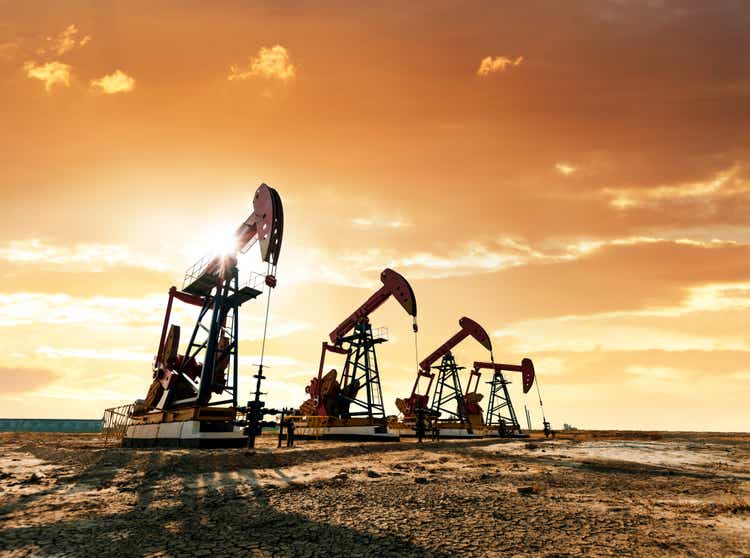baona
Ranger Oil (NASDAQ:ROCC) recently announced strong preliminary Q3 2022 results. It reported total production that was around 2% higher than the midpoint of its guidance range and oil production that was around 1% above the midpoint of its guidance range. Ranger’s capital expenditures were around expectations for the quarter, and it appears to be successfully navigating the supply chain and service cost inflation issues that have resulted in some producers reporting significantly lower production than expected without any benefit to capex.
Ranger’s net debt at the end of 2022 may end up a bit higher than what I previously expected due to it running a third rig in Q4 2022 (contrary to previous plans for two rigs during the quarter). However, Ranger’s 2023 production will benefit from this added investment. I have now bumped Ranger’s estimated value up to around $42 to $43 in a long-term (after 2023) $70 WTI oil environment.
Solid Production Performance
Ranger reported around 42,600 BOEPD in production in Q3 2022, above its Q3 2022 guidance range for 40,900 BOEPD to 42,500 BOEPD in total production. Oil volumes (at around 30,700 barrels per day) were within its guidance range of 29,900 barrels per day to 31,100 barrels per day, but slightly above the guidance midpoint of 30,500 barrels per day.
Cost Management
Producers have been dealing with supply chain issues (resulting in delayed completions) and service cost inflation, but Ranger Oil seems to be managing through this pretty well. Ranger’s Q3 2022 D&C capex ended up at $151.9 million, within its guidance range for $135 million to $160 million in total capex. It mentioned that $3.4 million of its Q3 2022 capex was due to D&C operations that were completed ahead of schedule. Excluding that $3.4 million would put its Q3 2022 capex very close to the middle of its guidance range for the quarter. Ranger also noted that it has been finding “innovative ways” to offset service cost inflation and get wells completed on time and on budget.
Ranger probably also benefits a bit from its Eagle Ford focus. While the Eagle Ford is also dealing with service cost inflation and supply chain bottlenecks, the situation there isn’t as bad as in the Permian Basin. Callon Petroleum mentioned that it accelerated part of its Eagle Ford development program due to the Permian bottlenecks it was encountering.
Future Outlook
At current strip (and with its solid production performance), Ranger would be expected to generate approximately $170 million in positive cash flow in the second half of 2022 based on its development plans (as of August) for the rest of the year.
Ranger has since modified its plans though. It previously expected to go down to two rigs for Q4 2022, after using a third rig for part of Q2 2022 and Q3 2023. However, it now plans to go with a three-rig development pace for the rest of 2022. This may result in its Q4 2022 D&C capex approaching $150 million, compared to the roughly $100 million to $110 million that I would have expected earlier.
This additional spend would have minimal impact on 2022 results, but would benefit Ranger’s 2023 results. Ranger also noted that it may continue with three rigs during 2023, which would result in significant production growth if there is a three-rig development plan throughout the whole year. A two-rig development program during 2023 would likely keep production flat to low single-digits growth from 2H 2022 levels, while a three-rig development program could result in around 10% growth versus 2H 2022 levels.
Notes On Valuation
I’ve bumped up Ranger’s estimated value slightly due to its better than expected production performance combined with its ability to keep costs relatively under control in an inflationary environment.
In a scenario where oil and gas stay at current strip until the end of 2023 and then average $70 WTI oil and $4.00 NYMEX gas (my base case scenario) after 2023, I now value Ranger at around $42 to $43 per share. It may be able to boost its value further through continued efficient development of its assets.
Conclusion
Ranger Oil has managed to avoid the supply chain issues that have hampered some other producers, allowing it to exceed production expectations for Q3 2022. It has also added a third rig again in Q4 2022 and could see roughly 10% production growth in 2023 versus 2H 2022 levels if it goes with a three rig development program for the full year. Ranger’s solid production results (while meeting capex expectations) helps boost its value to around $42 to $43 per share in a long-term $70 WTI oil scenario.


Be the first to comment